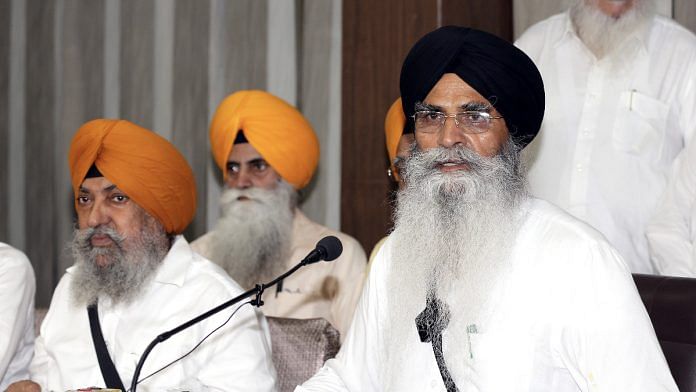Chandigarh: The Shiromani Akali Dal (SAD) managed to retain its hold over the Shiromani Gurdwara Parbandhak Committee (SGPC), with its candidate Harjinder Singh Dhami defeating Akali rebel Bibi Jagir Kaur in the Wednesday election held to elect the chief of the apex gurdwara authority.
While Dhami is the incumbent SGPC president, Kaur has headed the panel on three earlier occasions. Dhami won with a comfortable margin, cornering 104 votes out of the 146 votes. His rival, Jagir Kaur, got the remaining 42 votes.
Wednesday’s election was a crucial litmus test for the Akalis who were faced with the possibility of losing their decades long control over the SGPC.
“I thank Akal Purakh, Khalsa Panth and SGPC members for giving a resounding rebuff to anti Sikh conspirators and their stooges by reposing faith in the Akali Dal,” SAD president Sukhbir Singh Badal tweeted, after his party’s candidate retained the SGPC presidency
The SGPC president, a 11-member executive body and office bearers are responsible for the day-to-day working of the Committee. They are elected every year from among the members of the SGPC.
Usually the elections take place in November each year. Since the majority of the SGPC members owe their allegiance to the SAD, these elections are, generally, a cakewalk for the Akali candidates.
A statutory body created under the Sikh Gurdwara Act 1925, the SGPC controls and manages hundreds of other Sikh gurdwaras — some of them historical — in Punjab, Haryana, Himachal Pradesh and Chandigarh.
The SGPC is an influential authority as it commands not just the functioning of some of the biggest gurdwaras but is responsible for their financial management as well. The Golden Temple alone has an annual budget of Rs 1,000 crore. The SGPC office is within the premises of the Golden Temple in Amritsar.
The panel draws temporal strength by working in tandem with the five takhts or seats of power of the Sikhs, including the Akal Takht Amritsar which is considered to be the highest Sikh temporal body. The high priests of the five takhts are ex officio members of the SGPC.
Apart from managing gurdwaras, the SGPC is entrusted with the task of spreading the Sikh religion. It is the final authority in cases where either Sikhs or non-Sikhs come into conflict with the conventions and traditions of Sikhism.
It also exhorts Sikhs across the world to uphold the Sikh Rehat Maryada (code of conduct). The SGPC is the lone authority that can print and distribute saroops (forms) of the Guru Granth Sahib. The panel also runs several education institutions, including schools, colleges, polytechnics, universities, a medical and a dental college.
The SGPC also takes up Sikh issues with governments, both India and foreign, if their rules and regulations compromise the maryada of any Sikh.
Apart from being baptised Sikhs, SGPC members are expected to be adept in the knowledge of Sikh history and scriptures. They are expected to be spiritual besides strictly adhering to the Sikh rehat maryada. However, some SGPC members including some presidents have been mired in various controversies over the years including charges of corruption and misconduct.
Also Read: ‘Remain vigilant against forced conversion in Punjab’ — Sikh clergy’s message to devotees
SGPC elections
The creation of the SGPC was the result of the Gurdwara reform movement of the 1920s as part of which Sikh leaders wrested control of the gurdwaras from mahants, or the hereditary managers of the gurdwaras. The gurdwara reform movement culminated in the adoption of the Sikh Gurdwaras Act 1925 that established the SGPC as a body corporate.
Of the 191 SGPC members, 170 are elected by Sikhs through ballot paper voting in Punjab, Haryana, Himachal Pradesh and Chandigarh every five years. The elections are conducted by the Gurdwara Election Commission, which was set up for the purpose under the Act. As many as 15 members are nominated from among prominent Sikhs across India while 6 include the five high priests and the Golden Temple’s head granthi.
Only Sikhs registered as voters by the Gurdwara Election Commission are allowed to vote in the SGPC elections. Registered voters include Sikh men and women who are keshdharis (those who have not shorn hair), but may or may not be amritdharis (baptised Sikhs). The registered voters should also not be smokers or take alcoholic drinks.
The last SGPC election took place in 2011. Back then, 57 lakh voters were registered out of which 60 per cent cast their ballots. The SAD won 157 of the 170 seats.
Although most of the major political parties field their candidates, the SAD virtually holds an unbroken control over the SGPC for the past few decades. The SAD’s history is as old as that of the SGPC, and the party was created as the SGPC’s task force in 1920.
The Akalis face severe criticism from their political opponents for having a vice-like grip over the SGPC working using Sikh institutions in furthering their political interests.
Sehajdhari Sikh controversy
Sehajdhari Sikhs — who may or may not use any of the five Ks of the Sikhs: kesh (unshorn hair and beard), kanga (comb), kara (iron bracelet), kachhera (undergarment) and kirpan (sword) — are not allowed to vote following in amendment to the Sikh Gurdwara Act in 2016.
An amendment to the Act in 1944 allowed Sehajdhari Sikhs to vote in the SGPC elections, but a 2003 notification of the Punjab government took away this right.
As the Sehajdhari Sikhs were not allowed to vote in 2011, the Sehajdhari Sikh Federation approached the Punjab and Haryana High Court challenging the 2003 notification.
(Edited by Tony Rai)
Also Read: Fiery orator, ‘Bhindranwale 2.0’ — who’s Amritpal Singh, new ‘head’ of Deep Sidhu’s Waris Punjab De






